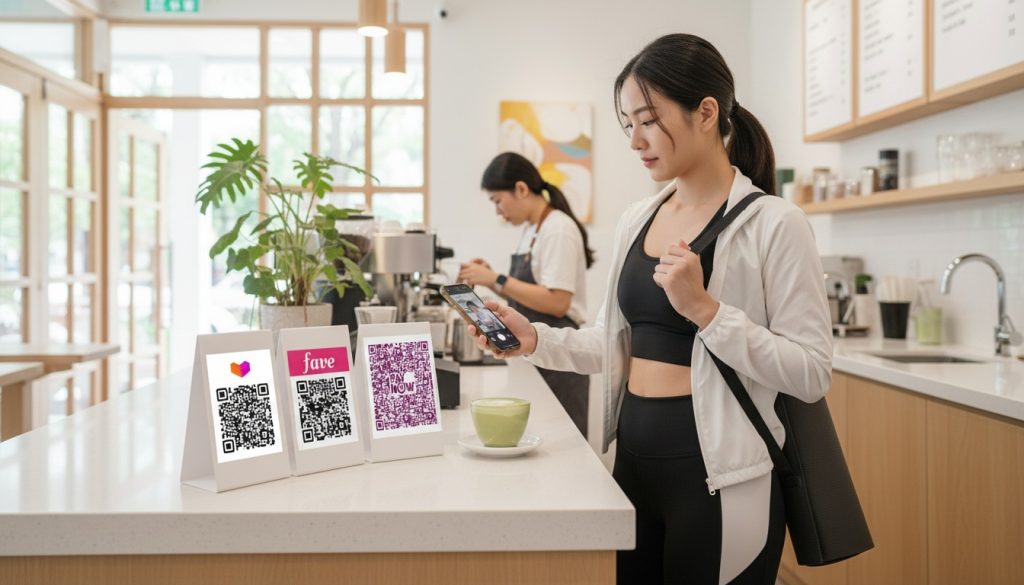A few years ago, when QR payments were just starting to take off, it was common to see shops and restaurants display multiple QR codes at their cashier counter.
For example, there was one QR code for PayNow, one for GrabPay, one for FavePay. And when a new payments startup entered the market, you had to display yet another QR code.
So in 2018, the Singapore government decided to launch a program to include all the various payment options in a single QR code. They called it SGQR.
SGQR combines multiple QR payment options into a single QR code. And PayNow is one of the payment options available in it.
It was a great idea. Suddenly, all the hawkers, kiosks, cafes and shops reduced their cashier space to just one QR code. And when a customer scanned it, their phone would ask them which payment method they wanted to use for this transaction.

Should You Add It To Your eStore?
The introduction of a single SGQR code is good for physical retailers, but for eCommerce sellers, you don’t need to consolidate all your payments into just one SGQR code. Reasons:
- SGQR does not cover some international options, such as PayPal, Google Pay or Apple Pay.
- Other payments like VISA or Master can be included, but international customers would not be able to scan an SGQR code anyway. They won’t have the correct app.
- So, you should keep cards or other methods as separate options in your checkout screen.
- SGQR codes cannot include the payment amount automatically. The customer needs to type it in after scanning.
SGQR vs PayNow in plain English
Many people still have a hard time distinguishing between SGQR and PayNow. That’s why many people ask “what is SGQR PayNow” as if it’s the same thing.
So let’s make this simpler. PayNow is a payment method; SGQR is a QR code that can include PayNow.
For ecommerce, you don’t need a SGQR sticker on your website. But you definitely should accept PayNow. And the easiest way to accept PayNow is to show a digital PayNow QR code on the order confirmation page. That is enough for Singapore buyers to scan and pay.
Why you should add PayNow
Cards have fees
Card processors typically charge a percentage plus a fixed fee. For example, a S$200 order at roughly 3.4% + S$0.50 costs about S$7.30 in fees. Switching eligible Singapore customers to PayNow reduces or removes those percentage fees, so more of each sale stays with you.
You get the money instantly
PayNow is real‑time. Funds appear in seconds, any time of day. That matters for small teams who need to buy stock, pack orders, or pay vendors without waiting days for card settlements. Faster cash means you can fulfil orders sooner and avoid short‑term liquidity headaches.
Customers expect it
QR payments are common in Singapore. If your PayNow option looks unfamiliar or lacks clear instructions, then shoppers may give up.
So, do you need SGQR PayNow?
As mentioned above, SGQR and PayNow are different things. You should definitely accept PayNow. But whether to display an SGQR code depends on whether you are selling in person or online.
If you have physical retail or pop-ups
- Print an SGQR label if you want to accept multiple schemes from one sticker. It keeps your counter tidy and lets customers pay with PayNow, e‑wallets or other supported rails without separate logos. However, you must already be registered to accept all the other payment options that you want to include in the SGQR code.
- Or, just install the SGPayNowQR Android app for offline QR generation at stalls. This is useful when you don’t want to print lots of stickers or when you change prices on the fly.

If you have online checkout for Singapore buyers
- For ecommerce, a dynamic PayNow QR per order is the best. Generate a QR that prefills the exact amount and the order ID so payments match automatically.
- Use your UEN rather than a mobile number where possible. The legal name that appears in the banking app helps buyers trust the payment and reduces support questions.
- Show the QR on the post‑checkout page and include the same QR in the order confirmation email as a fallback. Also include copyable fallback text: UEN, amount, and order ID.
- If you use WooCommerce, you can enable PayNow QR code with this plugin. And all transactions are commission-free.
If you sell online to both local and overseas buyers
- Accept cards in your checkout alongside PayNow. PayNow covers many Singapore buyers but not everyone abroad.
- For high‑value orders, offer an alternate bank transfer or card option in case customer bank limits block PayNow payments.
- Make it obvious: label payment options clearly and show short notes about who each option suits (e.g., “PayNow (for Singapore customers).
FAQs about SGQR PayNow for ecommerce
Do I need an SGQR sticker on my website?
No. A digital PayNow QR at checkout or on the order confirmation page is sufficient for online orders.
Should I use UEN or mobile?
Use your UEN when possible. UEN displays your business name in the payer’s banking app and looks more professional on statements.
Can customers pay with wallets by scanning my PayNow QR?
Only if the wallet app supports PayNow. Some bank‑linked wallets, such as DBS PayLah!, can pay via PayNow when they are linked to the PayNow service.
Can overseas customers pay via SGQR?
Only when they have an app that supports SGQR, such as UOB TMRW, DBS, OCBC, Grab, and FavePay.
Bonus: See this document for more PayNow and SGQR questions
Add PayNow To Your WooCommerce Store in 5 Minutes
Get more order, get paid faster, and do it without paying any transaction feed. Install the SGPayNowQR plugin.





